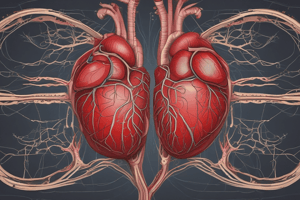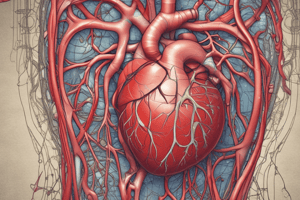Podcast
Questions and Answers
What is the main function of the heart?
What is the main function of the heart?
- To regulate body temperature
- To remove waste products from the body
- To distribute hormones and immune cells
- To pump blood throughout the body (correct)
Which of the following is NOT a structure of the heart?
Which of the following is NOT a structure of the heart?
- Pulmonary artery
- Ventricles
- Atria
- Small intestine (correct)
What is the term for a condition where veins fail to adequately return blood to the heart?
What is the term for a condition where veins fail to adequately return blood to the heart?
- Chronic Venous Insufficiency (CVI) (correct)
- Cardiac Insufficiency
- Heart Failure
- Venous Hypertension
Where is the heart located in the body?
Where is the heart located in the body?
What is the outer layer of the pericardium?
What is the outer layer of the pericardium?
Which chamber of the heart pumps oxygenated blood to the body?
Which chamber of the heart pumps oxygenated blood to the body?
What is the term for the valve that separates the right atrium and ventricle?
What is the term for the valve that separates the right atrium and ventricle?
What is the term for the blood vessels that supply oxygenated blood to the heart itself?
What is the term for the blood vessels that supply oxygenated blood to the heart itself?
What is the function of arterioles in the circulatory system?
What is the function of arterioles in the circulatory system?
Which branch of the aortic arch supplies blood to the right arm?
Which branch of the aortic arch supplies blood to the right arm?
What is hypertension clinically defined as?
What is hypertension clinically defined as?
What is an aneurysm in the context of the aorta?
What is an aneurysm in the context of the aorta?
What is the primary function of veins?
What is the primary function of veins?
Which branch of the abdominal aorta supplies blood to the stomach, liver, gallbladder, pancreas, and spleen?
Which branch of the abdominal aorta supplies blood to the stomach, liver, gallbladder, pancreas, and spleen?
What is the function of the left common carotid artery?
What is the function of the left common carotid artery?
What is the function of the inferior mesenteric artery?
What is the function of the inferior mesenteric artery?
What is the primary function of the fibrous pericardium?
What is the primary function of the fibrous pericardium?
What is the role of the serous pericardium?
What is the role of the serous pericardium?
What is the function of the sinoatrial (SA) node?
What is the function of the sinoatrial (SA) node?
What is the purpose of the coronary circulation?
What is the purpose of the coronary circulation?
What is the result of coronary artery occlusion?
What is the result of coronary artery occlusion?
What is the purpose of the pericardium?
What is the purpose of the pericardium?
What is the role of the atrioventricular (AV) node?
What is the role of the atrioventricular (AV) node?
What is the importance of proper coronary circulation?
What is the importance of proper coronary circulation?
Flashcards are hidden until you start studying
Study Notes
Chronic Venous Insufficiency (CVI)
- A condition where veins fail to adequately return blood to the heart, often due to valve dysfunction
- Symptoms include leg swelling, skin changes, and ulcers
Anatomical Location and Main Morphological Features of the Heart
- Located in the thoracic cavity, between the lungs and slightly to the left of the midline
- Enclosed within the pericardium, a double-walled sac consisting of the fibrous pericardium (outer layer) and the serous pericardium (inner layer)
- Conical shape with its apex pointing downward, to the left, and anteriorly
- Four chambers: two atria (upper chambers) and two ventricles (lower chambers), separated by septa
Functions of the Heart
- Primary function is to pump blood throughout the body, delivering oxygen and nutrients to tissues and removing waste products
- Maintains blood pressure by regulating the volume of blood pumped and the force of contraction
- Plays a role in the regulation of body temperature and the distribution of hormones and immune cells
Main Structures of the Heart and Cardiac Chambers
- Atria (right and left), ventricles (right and left), valves (tricuspid, pulmonary, mitral, and aortic), coronary arteries, and coronary veins
- Right atrium receives deoxygenated blood from the body via the superior and inferior vena cavae
- Left atrium receives oxygenated blood from the lungs via the pulmonary veins
- Right ventricle pumps deoxygenated blood to the lungs via the pulmonary artery
- Left ventricle pumps oxygenated blood to the body via the aorta
Arterioles
- Small arteries involved in fine-tuning blood flow to individual tissues and regulating systemic blood pressure through their constriction and dilation
Aorta and Its Branches
- Ascending aorta, aortic arch, and descending aorta (which further divides into the thoracic and abdominal aorta)
- Main branches of the aortic arch include:
- Brachiocephalic trunk (artery): Supplies blood to the right subclavian artery and the right common carotid artery
- Left common carotid artery: Supplies blood to the left side of the head and neck
- Left subclavian artery: Supplies blood to the left arm
- Main branches of the abdominal aorta include:
- Celiac trunk (artery): Supplies blood to the stomach, liver, gallbladder, pancreas, and spleen
- Superior mesenteric artery: Supplies blood to the small intestine and the first part of the large intestine (colon)
- Inferior mesenteric artery: Supplies blood to the distal part of the large intestine (colon) and the rectum
Hypertension and Aneurysm
- Hypertension: Clinically defined as persistently elevated blood pressure, typically diagnosed when systolic blood pressure consistently measures 130 mm Hg or higher, or diastolic blood pressure consistently measures 80 mm Hg or higher
- Aneurysm: Abnormal bulge or ballooning in the wall of a blood vessel, potentially leading to life-threatening complications such as rupture if left untreated
Functions of Veins
- Carry deoxygenated blood from the body's tissues back to the heart
- Primary functions include:
- Returning deoxygenated blood to the heart for reoxygenation in the lungs
Layers of the Pericardium and the Heart
- Pericardium consists of two layers: the fibrous pericardium (outer layer) and the serous pericardium (inner layer)
- Fibrous pericardium: Composed of dense connective tissue and provides protection and anchorage for the heart
- Serous pericardium: Secretes serous fluid, reducing friction between the heart and surrounding structures
Conducting System of the Heart
- Consists of specialized cardiac muscle cells responsible for generating and conducting electrical impulses that regulate the heart's rhythm and contraction
- Components include:
- Sinoatrial (SA) node
- Atrioventricular (AV) node
- Bundle of His
- Bundle branches
- Purkinje fibers
Coronary Circulation and Functional Significance
- Coronary circulation refers to the network of blood vessels that supply oxygenated blood to the heart muscle (myocardium)
- Coronary arteries (right and left) originate from the aorta and branch throughout the myocardium, delivering oxygen and nutrients
- Coronary artery occlusion can lead to myocardial infarction (heart attack), resulting in tissue damage and impaired cardiac function
Studying That Suits You
Use AI to generate personalized quizzes and flashcards to suit your learning preferences.





